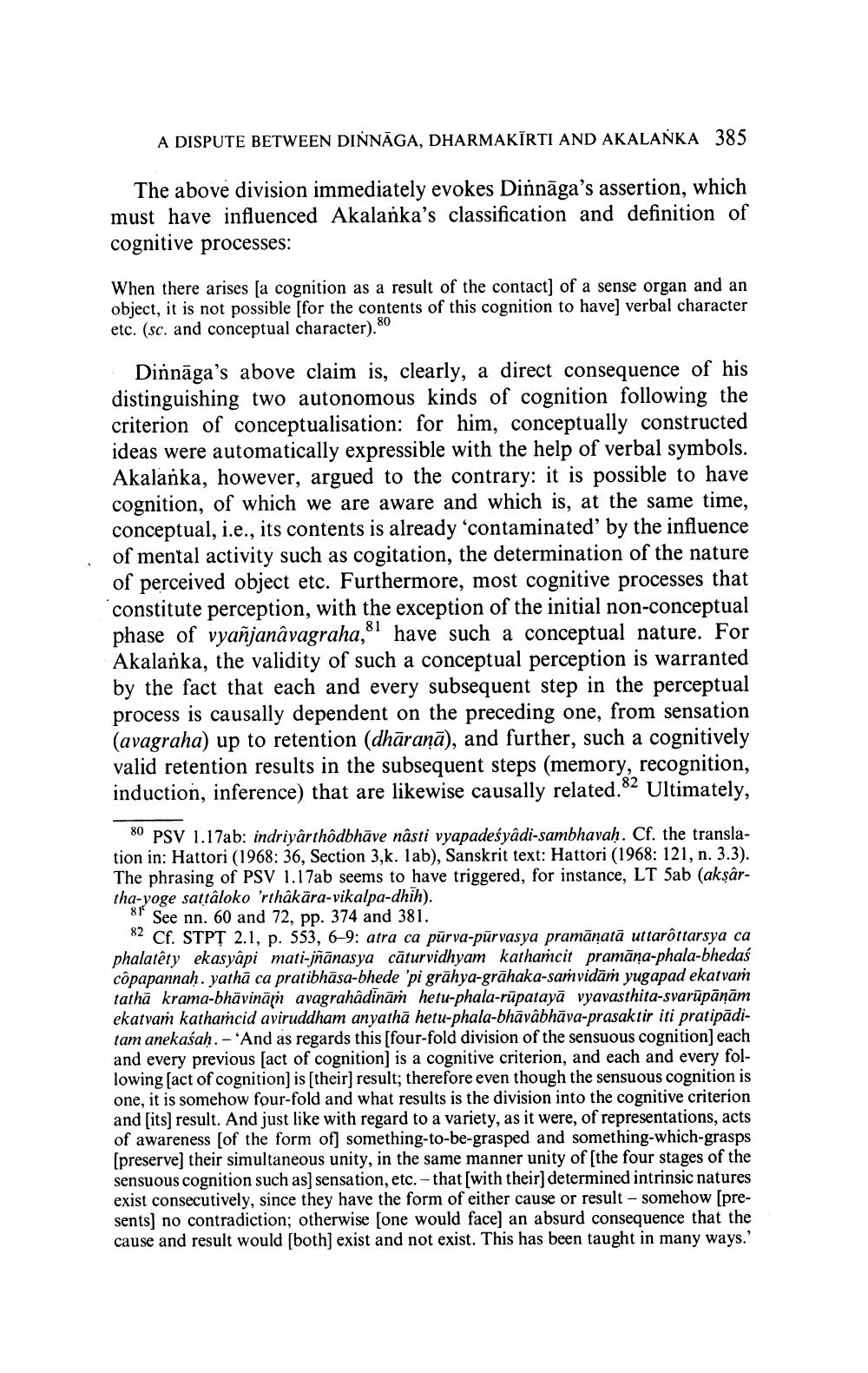________________
A DISPUTE BETWEEN DINNĀGA, DHARMAKĪRTI AND AKALANKA 385
The above division immediately evokes Dinnāga's assertion, which must have influenced Akalanka's classification and definition of cognitive processes:
When there arises (a cognition as a result of the contact] of a sense organ and an object, it is not possible [for the contents of this cognition to have) verbal character etc. (sc. and conceptual character). 80
Dinnāga's above claim is, clearly, a direct consequence of his distinguishing two autonomous kinds of cognition following the criterion of conceptualisation: for him, conceptually constructed ideas were automatically expressible with the help of verbal symbols. Akalanka, however, argued to the contrary: it is possible to have cognition, of which we are aware and which is, at the same time, conceptual, i.e., its contents is already contaminated by the influence of mental activity such as cogitation, the determination of the nature of perceived object etc. Furthermore, most cognitive processes that constitute perception, with the exception of the initial non-conceptual phase of vyañjanâvagraha, have such a conceptual nature. For Akalanka, the validity of such a conceptual perception is warranted by the fact that each and every subsequent step in the perceptual process is causally dependent on the preceding one, from sensation (avagraha) up to retention (dhāraņā), and further, such a cognitively valid retention results in the subsequent steps (memory, recognition, induction, inference) that are likewise causally related.82 Ultimately,
80 PSV 1.17ab: indriyârthôdbhāve nâsti vyapadesyâdi-sambhavah. Cf. the translation in: Hattori (1968: 36, Section 3,k. lab), Sanskrit text: Hattori (1968: 121, n. 3.3). The phrasing of PSV 1.17ab seems to have triggered, for instance, LT 5ab (akşârtha-yoge sattâloko 'rthâkāra-vikalpa-dhih).
8See nn. 60 and 72, pp. 374 and 381.
82 Cf. STPT 2.1, p. 553, 6-9: atra ca pürva-pürvasya pramanatā uttaröttarsya ca phalatêty ekasyâpi mati-jñānasya cāturvidhyam kathamcit pramāņa-phala-bhedas côpapannah. yathā ca pratibhāsa-bhede 'pi grāhya-grāhaka-samvidāṁ yugapad ekatvam tathā krama-bhāvinām avagrahâdināṁ hetu-phala-rūpatayā vyavasthita-svarūpāņām ekatvam kathaṁcid aviruddham anyathā hetu-phala-bhāvābhāva-prasaktir iti pratipāditam anekaśah. - 'And as regards this (four-fold division of the sensuous cognition) each and every previous (act of cognition) is a cognitive criterion, and each and every following (act of cognition) is (their) result; therefore even though the sensuous cognition is one, it is somehow four-fold and what results is the division into the cognitive criterion and [its) result. And just like with regard to a variety, as it were, of representations, acts of awareness (of the form of] something-to-be-grasped and something which-grasps (preserve their simultaneous unity, in the same manner unity of [the four stages of the sensuous cognition such as sensation, etc. - that (with their] determined intrinsic natures exist consecutively, since they have the form of either cause or result - somehow (presents) no contradiction; otherwise [one would face) an absurd consequence that the cause and result would [both) exist and not exist. This has been taught in many ways.'




